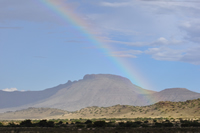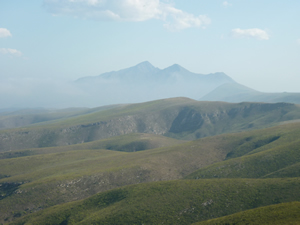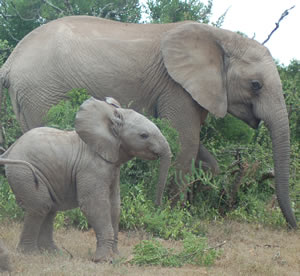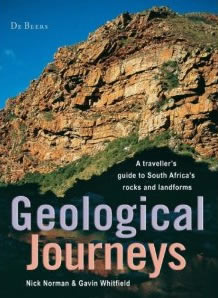



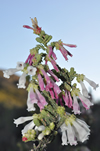
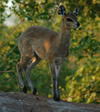

Blue Hill Escape
Hébergement et Réserve Naturelle
Cap-Occidental, Afrique du Sud

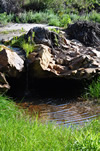





Facts and Attractions
The Baviaanskloof
|
Blue Hill Escape borders onto the Baviaanskloof Nature Reserve, which covers some 192 000 hectares of pristine mountain wilderness. Baviaanskloof is named after the baboons that roam wild there. It is home not just to baboons but also to several species of antelope, cape leopard, the endangered cape mountain zebra and black rhino, and a wealth of plant and bird life. |
Addo Elephant National Park
|
Addo Elephant National Park lies about 250 km east of Uniondale and is a great place to see the Big Five - elephant, rhino, lion, buffalo, leopard; or even the Big Seven (Big Five plus southern right whale and great white shark). Many other iconic South African wildlife such as giraffe and zebra can also be easily encountered. Baviaanskloof Wilderness Area and Addo Elephant National Park are two of the top 10 wildlife wonders and natural attractions of the Eastern Cape. |
The Garden Route
|
One of the main attractions of the Western Cape is only a two hour drive from us: The Garden Route. This is the coastal road (N2) between Cape Town and Port Elizabeth, famous for its endemic fynbos flora and its secluded little bays.
|
And then there is the Little Karoo itself with its scenic Route 62 from Montagu to Oudtshoorn, the capital of the Klein Karoo and just a two hour drive from us. Oudtshoorn is the gateway to some of the area's main attractions, such as the Cango Caves, known as the ‘underground wonderland of the Klein Karoo’, and the annual arts festival. The Little Karoo is also famous for its many scenic mountain passes over the Swartberge, the Kouga, Kammanassie, Outeniqua and Tsitsikamma Mountains.
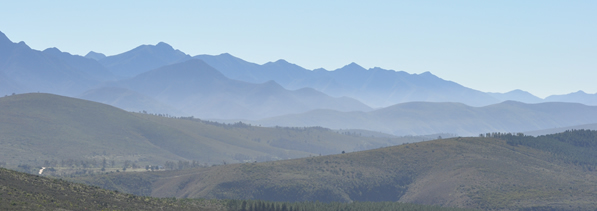
The background of the website you are viewing is a photo
of the blue Karoo sky. We lie on the eastern endof this arid valley, about
250 km long and 60 km wide. Its flat plains and rolling hills are broken
by several isolated ridges and mountains, the highest reaching up to 2000
m. The soils in the valleys are predominantly shallow and stony and support
succulent karoo shrubs that are adapted to survive on the low annual rainfallof
125 to 300 millimetres. Like many arid areas, the Little Karoo experiences
dramatic variations in daily temperatures, and ranges of as much as 28
degrees are not uncommon. Daytime temperatures in the valleys sometimes
soar to 44 degrees in summer and can plunge to below freezing in winter.
For
more information read Leon Nell's book: The Garden Route and Little Karoo:
Between the Desert and the Deep Blue Sea
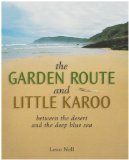
As a rule of thumb it can be said that on every day of the year at some point during the day the weather will be pleasant.

The Blue Hill Escape is 1000 m asl and although we are only a two hour’s drive from the coast, our climate is quite different from the mild weather there. The summer months, especially January and February, can get very hot and 40°C are not uncommon. Winter in turn brings frost and sometimes even snow. Nights can be cool even in summer and it is recommended you bring some warm clothes no matter which time of year you are visiting. It is generally very sunny and dry so rain is greeted with joy when it comes. There are no defined rain patterns as we are between the summer rainfall zone to the north-east and the winter rainfall area along the coastal Cape to the south-west. Days without at least a light breeze are rare. Stronger winds bring hot weather from the north; and very cold weather when coming from the south (but you can't quite see Antarctica).

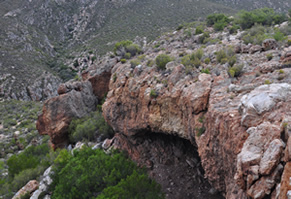
Blue Hill Escape is named for the Bloukop peak on the property, part of the Kouga mountain range. But one of the most fascinating aspects of the local geology is the old continental surface, locally known as the oorvlakte.
The view from Uniondale Heights on approaching Uniondale on the N9 is striking: Three prominent flat-topped hills, "mesas", dominate the vista. These are the remains of the ancient African Surface, which occurs throughout southern Africa.
The African Surface originated through a very long geological event of 90 million years duration. Erosion started with the breakup of the Gondwana supercontinent, and reduced the landsurface to an undulating plain, with the erosion resistant sandstone and quartzite standing proud of the plain as impressive peaks; the most prominent peak of Table Mountain sandstone is Mannetjiesberg visible to the NW of the village. The altitude is 1956 metres, around the same elevation as Johannesburg. A drive along the Uniondale Poort road towards Avontuur reveals the sandstone rocks close up; there are several stopping points where bedding (from when the rocks were laid down) and folding (caused by the great upheavals the rocks underwent) can be examined.
The ancient weather was warm and wet for a long time, and thus the rocks on the plain became deeply rotted. Water and wind worked on the sandstone fragments on the surface on the plain and in time many of the fragments were rounded to pebbles and small boulders that lie on the present day flat surface. While this surface was being formed, water carried silica and iron derived from the weathering into the rotted rocks below the plain, and cemented these into very hard duricrusts. The narrow cliffs seen at the crest of the mesas are the cemented jumble of angular and rounded rock fragments. Twenty million years back in time, and later about five million years ago southern Africa was raised by a further 200 to 900 metres; these events renewed the erosive energies of the rivers that formed the deep valleys, with the African Surface remnants seen today.
Soft, rotted rock is located beneath the duricrust. Weathering and erosion of the past few million years has removed the rotted rock and undercut the duricrust. In this way caves have come to be formed; the caves are of great significance in the history of land use by nature and man in the Uniondale area.
The caves are places of refuge for owls, swallows, bees, and small mammals. In later years they became habitation sites for humankind, and are the places where many of the San paintings of the Uniondale area are exhibited and preserved. Later use was by new farmers to the area, and sheep, goats and cattle were sheltered. The caves are generally abandoned now, while efforts are in place to preserve the art heritage of the San by limiting access to the sites.
If you are interested in Geology, a great book on the Earth's geology from the southern African perspective is Terence McCarthy's 'The Story of Earth and Life'. Otherwise Geological Journeys by Nick Norman and Gavin Whitfield is a great (if not the only) traveller's guide to South Africa's rocks and landforms. Click on an image below to learn more.
Flora
“Come see the magical fynbos in flower”

South Africa is a mega-diverse nation, not just in terms of its wildlife but especially because of its wealth of plants. Here you will find around 23 000 plant species, 7.5% of the world's total, and more plant species are being discovered every year. Seeing the fynbos (Afrikaans for “fine bush”) in flower is one of the highlights of a trip to South Africa – not just for botanists. September to October is the best time of year for this, but something is in flower all year round.
What is fynbos?
Fynbos is the characteristic vegetation of the Cape Floral Kingdom, the smallest of the six floral kingdoms of the world – with an astounding total of 9000 species. Of these, 6300 are endemic, occurring in a restricted area and nowhere else in the world (So if you would like to see something truly South African, this is it!), and 1400 are Red Data Book species, meaning that they are rare and/or threatened.
This hardy vegetation has adapted to the dry summer season and strong coastal winds in special ways: by producing large, hard, leathery leaves (as in the protea family); or fine, tiny leaves, often with rolled edges (the erica family); by having long, thin stems with no leaves (the reed family); or by means of underground storage organs (lilies and orchids).
Fynbos needs to burn in late summer, after flowering, and at well-spaced intervals (every 10-30 years), in order to rejuvenate the vegetation. The plants survive fire, either by producing many seeds, which are released by the heat of the fire, or by resprouting from their roots or underground storage organs.
The survival of fynbos is dependent upon a web of fascinating inter-species relationships. Indigenous ants are attracted to fatty baits on some of the seeds, and carry the seeds off to their nests underground, safe from predators. The flowers of some plants supply nectar to bees, sugarbirds and sunbirds, and are pollinated in turn, while ground proteas attract mice.
Vegetation types of the reserve
The water drainage lines are dominated by the Tsitsikamma perennial stream vegetation variant, the higher altitude areas are dominated by Kouga Mesic Proteoid Fynbos and Kouga Grassy Fynbos and parts of the lower lying areas to the east of the Blue Hill Nature Reserve are dominated by the Hartbeesvlakte Sandolien Renosterveld vegetation variant. More detailed descriptions of the broader habitat units (Sandolienveld, Grassy Fynbos and Mesic Proteoid Fynbos) and the specific vegetation variants of these habitat units that occur on the property can be read here in a document prepared by Alan Wheeler of Cape Nature.
“Come walk the hills where leopards and baboons roam wild”

You won't be able to see the famous Big Five on the Blue Hill Escape. Maybe you will see one of them, the leopard. But what you do get is a chance to see our local wildlife in its natural habitat, undisturbed by other people, and without the noise of a vehicle. Watch a troop of baboons silhouetted on top of a hill, the klipspringers perched on top of a rock looking down at you or mountain rhebok and gemsbok walking the hills in search of food. And did I mention that we almost have an elephant living here? Just a whole lot smaller: the dassie, its improbable closest relative. And if you like it more dangerous: Keep an eye out for the Cape cobra!

The Western Cape mountains and Karoo semi-desert are also famous for their bird life. Of Southern Africa's 86 endemics, 60 occur here along with half of the near-endemics. This is partly due to the mostly endemic vegetation type, the fynbos. Some of the birds associated with fynbos include sugarbirds and sunbirds.
The southern and eastern border of the Blue Hill Escape adjoins the 192 000 hectare Baviaanskloof Wilderness Area. Baviaanskloof is worth visiting not just because of its spectacular landscape and views but also for its wildlife. Some of the bigger mammals you can see within the reserve are leopard, buffalo, kudu, cape mountain zebra, red hartebeest, bushbuck, mountain rhebuck, eland, baboon and black rhino. Get in touch if you are interested in a local-led tour!
